Web3: A new era for social commerce
5 minute read | July 8, 2024

George Kassis
Vice President, Web3 Identity Lead, Kinexys Labs, Kinexys by J.P. Morgan
Introduction
In 2023, the social commerce market was valued at over $1 trillion and is forecasted to grow by 600% by 2030. This growth signals a transformative shift in consumer behavior – fueled by ever evolving technological advances.
Despite this rapid expansion, significant friction points persist within social media platforms. These issues start at product discovery, where users have limited control over social platform algorithms and how their data is leveraged for brand engagement. First-time shoppers often face trust issues due to insufficient trust signals from brands or small businesses on these platforms – including being redirected to the brands website external to the social apps which leads to cart abandonment.
This report explores the early paradigm shift from Web2 to Web3 and its impact on social commerce. Emerging Web3 social platforms, like Farcaster and Lens Protocol, and user-facing applications, such as Warpcast and Phaver, are gaining traction within the Web3 community. We explore the innovative functionalities that the Web3 ecosystem offers to users and brands, including using Web3 wallets, digital identity, open algorithms, and streamlined payments.
Join us as we explore the future of social commerce, discussing the potential of Web3 to revolutionize how we shop, interact, and build trust online. Discover how this shift could transform the user experience – making it more fun, transparent, and user-centric. Uncover the new tools brands can use within a social commerce construct to signal trust, and enable a curated shopping experience.
Download the report to learn more
Web2 Social Commerce
Since their debut 15+ years ago, early social media platforms were designed with the primary objective to enhance and enrich human connections. These early social networks cultivated vibrant online ecosystems through social networks, the sharing economy, gaming, e-commerce, and more.
As of 2024, over 5 billion people are active on social media, presenting an opportunity for businesses to drive sales directly through social interactions. The high volume in social commerce activity can be attributed to a combination of factors, such as a pandemic-driven push for social commerce, a shift in shopping behaviors, increased social media usage, the rise of influencer-driven content, and easier payment options. Users can discover products, read reviews, interact with other shoppers, and make purchases all within their favorite social media platforms.
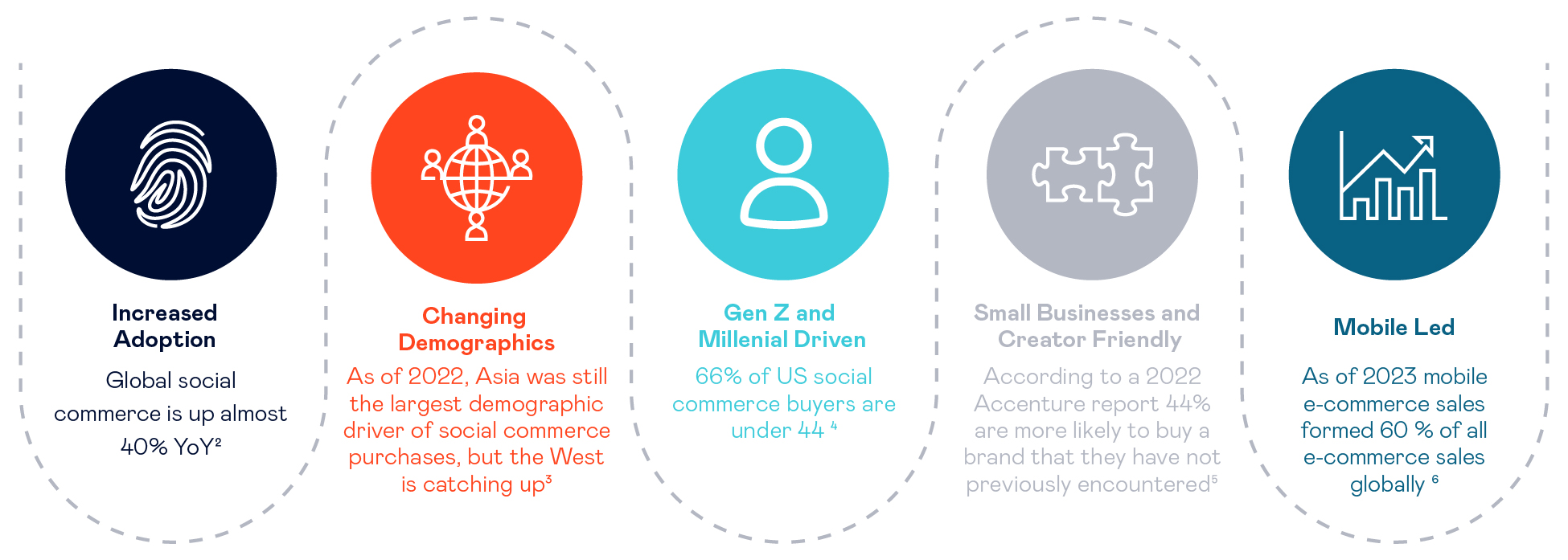
The social commerce user journey can be broken down into four key phases: discovery, trust, purchase, and brand affinity.
However, the four-step journey contains numerous friction points that lead to drop outs and cart abandonment which ultimately leads to a product not being purchased.
Nearly all friction points arise from the collection, use, and sharing of data. Most of these data points pertain to aspects of a user's identity. This identity-related data includes social network behaviors, shopping preferences, trust signals, shipping addresses, banking details, and preferred modes of ongoing engagement.
Paradigm Shift From Web2 to Web3 – Social Graphs and Digital Identity
Web3 is often described as the next evolution of the web, characterized by its decentralization, openness, modularity, interoperability, and blockchain foundation. The key difference between Web2 and Web3 is the ownership model – with the Web3 user in the control as opposed to centralized Web2 parties. For instance, creators in Web3 own the content they create and take it with them from one dApp (decentralized application) to another. This is a significant shift from the Web2 model whereby the underlying social network owns the content. In Web3 users have more power to own their identity, data, and other information related to them.
Web3 social networks represent a fundamental shift from current Web2 social platforms. Developers can select which building blocks across the stack to incorporate into their offerings, allowing for greater flexibility and innovation in creating decentralized applications.
Digital identity refers to how an individual or organization is identified and represented online or in the virtual world. It includes attributes that constitute a legal identity (such as name, date of birth, etc.). These attributes are often encapsulated in the form of verifiable credentials, whereby personal data within each credential typically remains off-chain.
However, holistic self-expression extends beyond legal names, addresses, or other similar attributes. To fully express themselves online, individuals can link their "social signals" (e.g., followers from their social graphs, digital art they have created, and their favorite blog collections).
The concept of "Bring Your Own Identity" (BYOI) within the Web3 ecosystem, highlighting the integration of various identity components into a Web3 wallet.
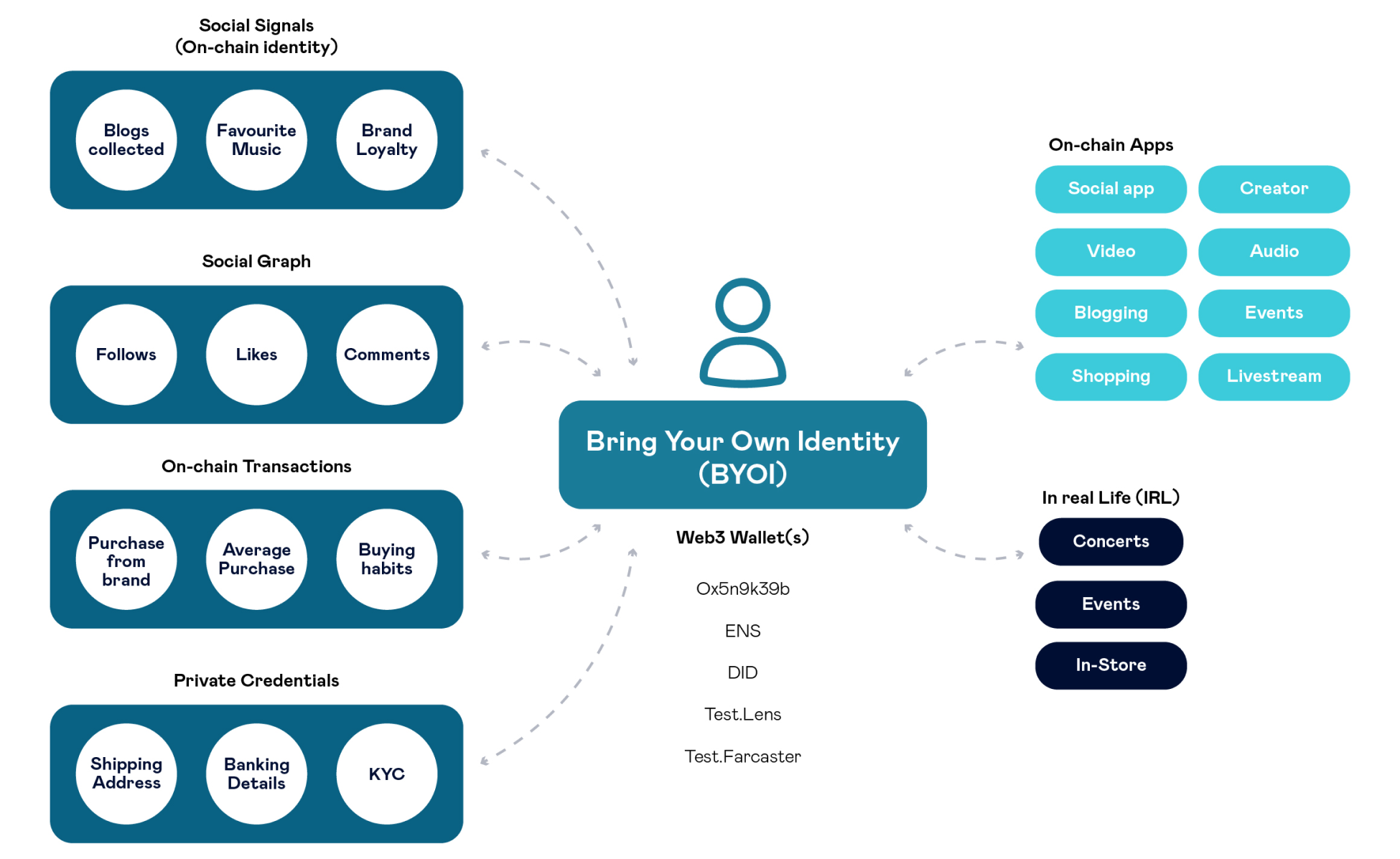
Personalization is a key feature of Web3 and unlocking its full potential requires on-chain attributes. This shift fosters community building and connecting people with similar social signals and interests who might not have met otherwise.
Web3 Social Commerce
Web3 social commerce integrates Web3 commerce functionalities within social media platforms, enables users to discover, share, build trust with brands, purchase products, and engage with brands in a more personalized and engaging manner through social interactions and community-driven content. In the following scenario, the Kinexys team illustrates the potential of Web3 social commerce and what the future capabilities may look like to help mitigate the friction points highlighted earlier on.
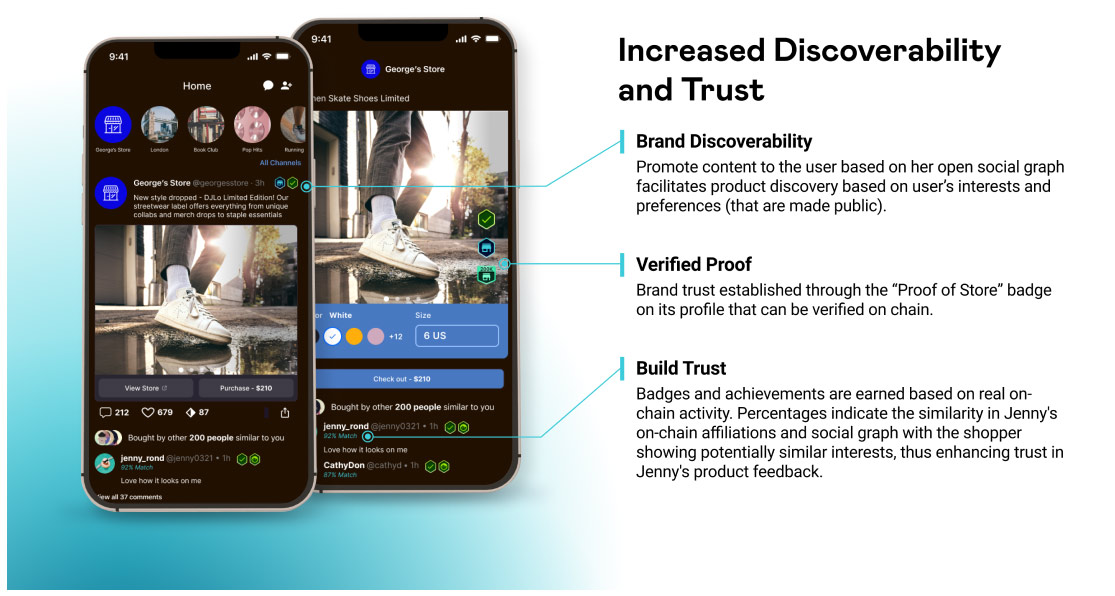
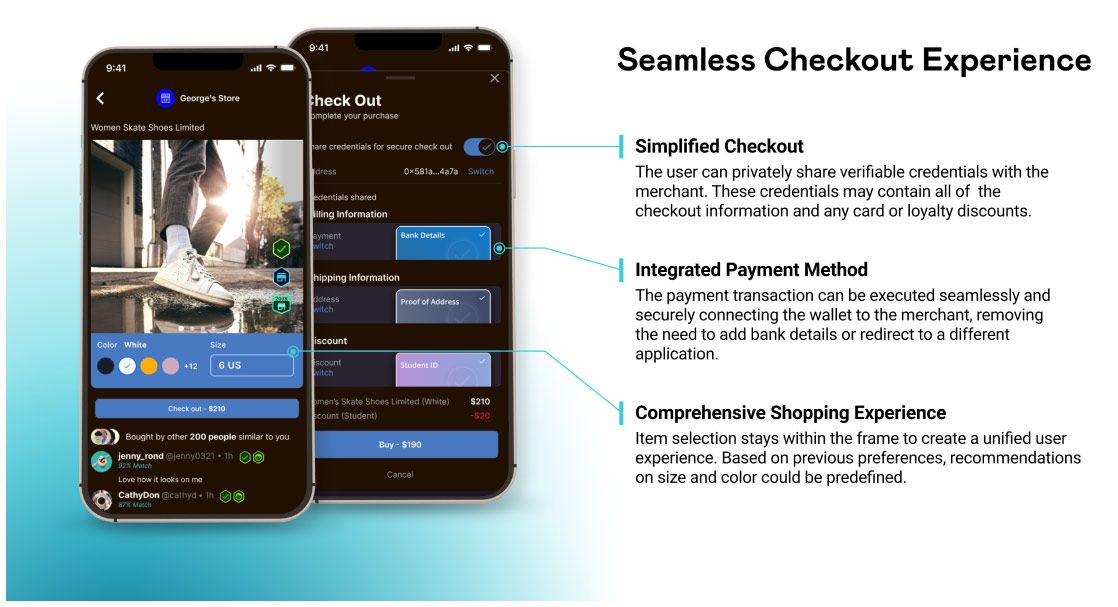
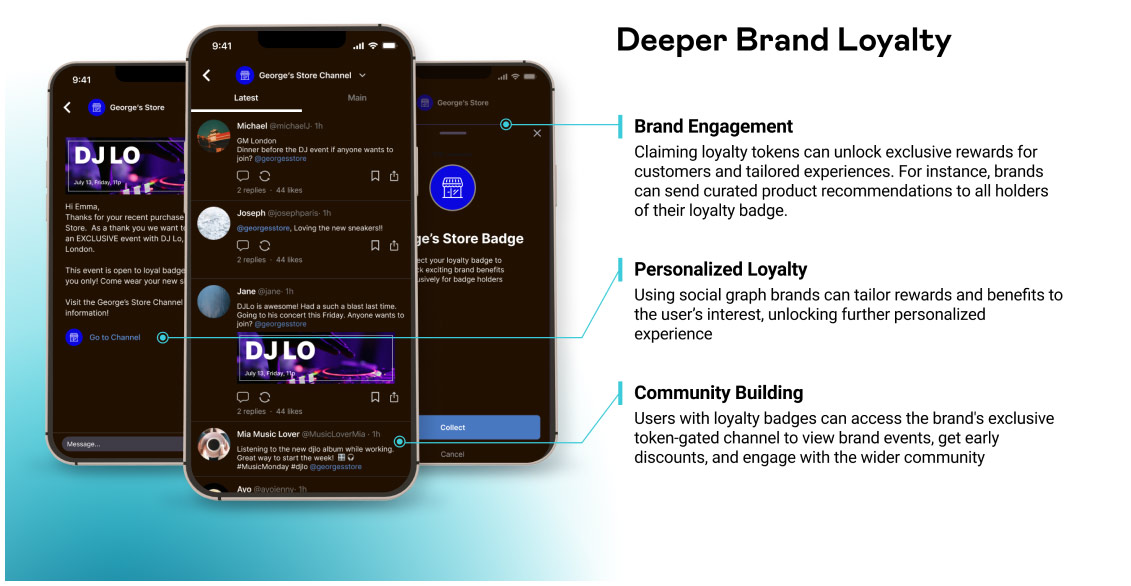
Within minutes, one would have discovered a new brand based on their open social graph, made a purchase without being redirected to a separate website, confidently checked out based on trust signals, joined a community, and got invited to an event. This shopping experience was not just transactional, it fostered engagement. Shoppers would be invested in their new community and continue to explore new product launches through the channel, extending their discovery journey and deepening their connection with the community.
Closing Thoughts
We are thrilled about the future of Web3 social commerce and continue to closely monitor ecosystem developments and emerging functionalities to enable the next wave of commerce.
At Kinexys, we are committed to fostering innovation within this space. We actively seek new ideas and contribute to driving the next wave of Web3 adoption. Our efforts include sponsoring and leading events like the Digital Identity Hackathon in 2023, which focused on the role of digital identity in the future of commerce. This event saw over 700 developers using our Kinexys Digital Identity Open-Sourced SSI SDK to tackle challenges in commerce, payments, and Web3 wallets.
We are excited to be part of this journey and look forward to continuing our support of and participation in the evolution of Web3 social commerce.
Download the report to learn more
- Alexandra Prager, Executive Director, Head of Kinexys Labs, Kinexys by J.P. Morgan
- Patricia Jaimez Gómez, Associate, Web3 Identity Product Manager, Kinexys by J.P. Morgan
- Aditya Taday, Associate, Technical Product Manager, Kinexys by J.P.Morgan
- Dylan Paul, Analyst, Product Manager, Kinexys by J.P.Morgan
- Shawn Rolling, Vice President, Experience Design, Kinexys by J.P.Morgan
- Haijing Zhang, Vice President, Experience Design, Kinexys by J.P.Morgan
- https://www.forbes.com/sites/bernardmarr/2022/01/24/what-is-web3-all-about-an-easy-explanation-with-examples/
- https://www.mckinsey.com/featured-insights/mckinsey-explainers/what-is-web3
- https://medium.com/@jacob.k_20195/web3-social-unpacking-the-stack-fb093ca7a0e2
- https://www.jpmorgan.com/kinexys/content-hub/digital-identity-in-web3
- https://sproutsocial.com/insights/social-commerce/
- https://www.ledger.com/academy/topics/crypto/what-is-token-gating
- https://sproutsocial.com/insights/social-media-statistics/
- https://offers.hubspot.com/social-media-trends-report
- https://www.tidio.com/blog/social-commerce-statistics/
- https://www.emarketer.com/insights/social-commerce-brand-trends-marketing-strategies/
- https://www.accenture.com/us-en/insights/software-platforms/why-shopping-set-social-revolution
- https://www.statista.com/chart/13139/estimated-worldwide-mobile-e-commerce-sales/
- https://hbr.org/sponsored/2023/06/3-ways-marketers-can-earn-and-keep-customer-trust
- https://blog.hubspot.com/marketing/why-consumers-dont-shop-on-social-media
- https://www.emarketer.com/insights/social-commerce-brand-trends-marketing-strategies